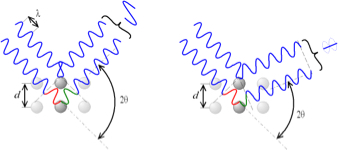Sizes of Atoms and Ions
- Page ID
- 53312
Skills to Develop
- Describe the significance of and periodic trend for atomic radii
What are Atomic Radii?
Atomic radii are the radii of atoms, a measure of how big the atoms are. That seems kind of simple. It's a useful idea because if we know the radii, we can predict how big molecules are, whether different parts will touch each other, etc. This is good for designing molecules for particular purposes, or interpreting data, and other things.
How do you Measure Atomic Radii?
This is where the trouble starts! Atoms are more like clouds than metal balls. It's easy to measure the diameter of a metal ball, because it doesn't change; the ball is hard. But how do you measure the size of a single cloud that is touching many other clouds? Remember from the nuclear model of the atom that the nucleus is very tiny. Almost all the space in an atom is taken by the electrons in their orbitals, and the orbitals, like clouds, don't have obvious edges; also, they can change size and shape when other atoms are nearby because of Coulomb forces from other nuclei and electrons. We usually measure the size of atoms using X-ray crystallography. Basically we shine X-rays on a crystal (like a salt crystal or a diamond, a crystal is an orderly arrangement of atoms with sharp, straight edges). The X-rays interact with the electrons in the crystal, and the picture we get from the X-rays can tell us the electron density at each point in the crystal. Most atoms have lots of electron density because they have 6 or more electrons. We can see how far apart these electron density peaks are, and that tells us where the atoms are. Then we guess their size based on how far away they are from each other. I say "guess" because the distance between atoms depends on whether they are bonding or not bonding, etc. So the size depends on the type of environment we look at. We can't look at all types of atoms in the same environment because they have different bonding properties, but by looking at lots of different situations we can see some general trends.

Predicting Relative Sizes
Because electrons are what take up space in atoms, the result is that the size of the biggest filled orbital determines the size of the atom or ion. Sizes of orbitals depend on the quantum numbers (n = 1, n = 3, etc.) and also on the effective nuclear charge. An orbital of any type will get smaller as the effective nuclear charge gets bigger, because the attraction to the nucleus is greater. As you go down the periodic table, usually atoms get bigger because n gets bigger (there are electrons in higher shells). Effective nuclear charge does get bigger too going down the periodic table, but this effect is smaller than the change in shell. As you go left across the periodic table, the effective nuclear charge increases. The number of electrons also increases, but they are usually in the same shell or subshell, so the effective nuclear charge increase is more important, and the atoms or ions get smaller going left. There are many exceptions, but for now bigger to the right and down is what you should remember.

The sizes of ions follow a simple pattern. When you remove electrons, making cations, there are less electrons and less electron-electron repulsions, so the cation is smaller than the atom. The more electrons you take off, the smaller it gets. Anions are the opposite. When you add electrons, they repel each other, and there are more of them, so anions are bigger than atoms, and get bigger as you add electrons. You can combine these patterns with the general pattern for atoms to predict relative size of ions.
In general, to predict relative sizes, ask: How many electrons? What shell? What effective nuclear charge? Find the differences between the particles you are comparing, and see what effect the differences should have.
Check out the Atomic Radii for yourself!
Go to Ptable's radius page, and look at the radii. Try selecting different types of radii, like calculated, empirical, covalent, and Van der Waals. Notice that some types of radii only have data for some elements, and that the patterns change a little depending on how you measure.
Outside Link
- Ionization Energy and Atomic Radii (10 min)
Contributors and Attributions
Emily V Eames (City College of San Francisco)

